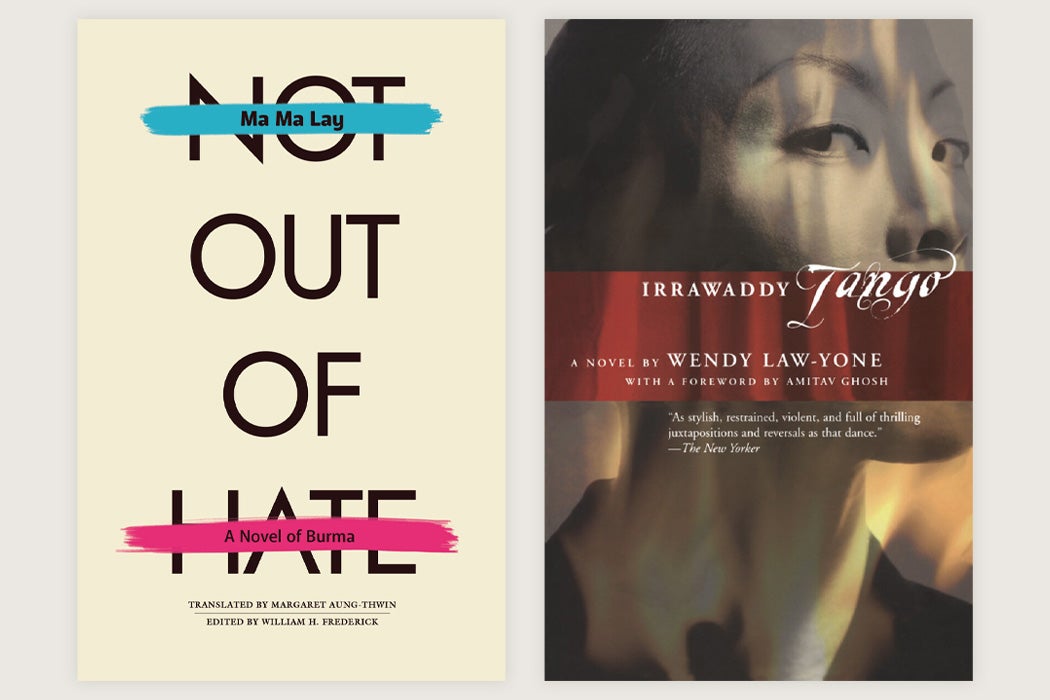In recent decades, the idea of “Burma” has become synonymous with a “human rights spectacle,” as women’s studies scholar Tamara C. Ho observes after analyzing media representations of her birthplace. But, even as news cameras turn to highly visible acts like protests and crackdowns, Burmese women’s voices are generally missing, notes Ho, who uses the terms Burma and Burmese for the country’s culture and peoples and Myanmar for the state and military governments after 1988.
In particular, Ho writes, the dominant narrative largely relegates Burmese women to the position of “silenced victims of trauma” associated with “orientalized and silenced abjection.” Yet these women themselves, navigating multiple forms of hegemony in their lives, “perceive visibility as a political necessity and a problematic of uneven power.”
To demonstrate how “[n]arratives by and about Burmese women map a history of discursive and gendered displacement,” Ho turns to two landmark novels published four decades apart: Ma Ma Lay’s Not Out of Hate (1955), which was the first Burmese work to be translated into English and published outside of the country, and Wendy Law-Yone’s Irrawaddy Tango (1993), by a writer who has been recognized as “[t]he first Burmese diasporic author to write in English.”
Not Out of Hate, which Ho describes as “an allegorical tragic romance,” depicts how its young protagonist, Way Way, gradually comes under the thumb of her overbearing, British-educated husband, U Saw Han. A dedicated Anglophile, U Saw Han “institutes Western regimes of dress, diet, and medicine, causing Way Way discomfort and distress,” Ho notes. For instance, he laughingly forces Way Way to drink milk, despite her distaste for it, until she throws up. Way Way initiates a parallel, secret life in which she returns to her father’s house, where she can pursue a more “traditional” lifestyle—at least until her father dies.
Ironically, given the religious strictures placed on women by Theravadan Buddhism, Way Way briefly finds refuge from “patriarchal imperatives” at a Buddhist center where her mother counsels novices. The protection is temporary, however, as she soon discovers she’s pregnant. She ultimately returns to her husband’s house.
In a role that Ho finds “[a]n uncanny harbinger of the Press Scrutiny Board” in Myanmar that enacts national censorship, U Saw Han restricts Way Way’s access to books given to her by her mother and limits the letters exchanged by the two women until “the diminishing size of [Way Way’s] handwriting literally marks the obliteration of Burmese women’s discourses.”
Moreover, Ho argues, Not Out of Hate uses the character of U Saw Han to depict a Western modernity where “[p]romises of ‘modernization,’ ‘progress,’ and ‘liberation’ demand and justify the expunction of alternative discourses (of spirituality, gender, culture, and power).”
Almost forty years later, Wendy Law-Yone’s Irrawaddy Tango follows eponymous and eccentric heroine Tango as she rises from a village girl in “Daya,” the fictionalized state of Burma/Myanmar, to become the wife of the national strongman and dictator, Supremo. Tango is kidnapped by rebels, at which point Supremo divorces her rather than negotiating her release. But Tango again rises, becoming a guerrilla leader in Daya, a prisoner of war, and then a refugee in the United States. In the US, she helps other Asian refugees, but events encourage her to return to her birthplace, where she reunites with Supremo and beats him to death.
Irrawaddy Tango is punctuated by episodes where Tango is in a state prison, writing her life story. Ho argues that “[t]he narrative frame of the incarcerated female writer suggests that authorial privilege is bound by one’s marked embodiment and delimited by hegemony.” At the same time, the prison becomes a site in which Tango has a place and opportunity to sit, think, and write. Burmese prisoners, including Tango, “creatively transform in carceration into opportunities for intellectual exchange and collective production.”
As Way Way did with Buddhism in Not Out of Hate, Tango finds refuge in indigenous beliefs—the concept of “butterfly soul” or leip-bya. According to Tango, the Burmese believe that “[w]hile the body plods through the lumpish tasks of living, the butterfly soul ranges unfettered through the open spaces of dreams, trances, wishes, reveries, and unconscious desires.” Ho argues that this “Southeast Asian-inflected standpoint” offers a spiritual path out of incarceration and embodiment. And it was the butterfly soul that “thwarted British regimes of punctuality and racialized authority” in the colonial era.
Weekly Newsletter
The protagonists of both novels also gain agency in language, whether through Way Way’s persistent letter-writing or Tango’s penchant for wordplay. (In a mordant example of Law-Yone’s wit, Tango, having killed Supremo by battering him violently with a fan, insists through “wild throes” of laughter and sobbing that “The fan hit the shit.”)
“Ma Lay and Wendy Law-Yone call attention to the problems and limits of representation while resisting the ways in which dissident (Burmese) subjectivities are disciplined, disappeared, and silenced,” Ho concludes. “Their novels signal how alternative knowledges can provide the disenfranchised, brutalized, and forgotten a way to resist oppressive structures of being.”







